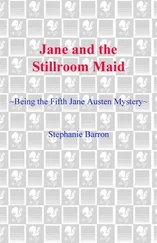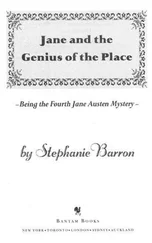Stephanie Barron - Jane and the Ghosts of Netley
Здесь есть возможность читать онлайн «Stephanie Barron - Jane and the Ghosts of Netley» весь текст электронной книги совершенно бесплатно (целиком полную версию без сокращений). В некоторых случаях можно слушать аудио, скачать через торрент в формате fb2 и присутствует краткое содержание. Жанр: Исторический детектив, Иронический детектив, на английском языке. Описание произведения, (предисловие) а так же отзывы посетителей доступны на портале библиотеки ЛибКат.
- Название:Jane and the Ghosts of Netley
- Автор:
- Жанр:
- Год:неизвестен
- ISBN:нет данных
- Рейтинг книги:4 / 5. Голосов: 1
-
Избранное:Добавить в избранное
- Отзывы:
-
Ваша оценка:
- 80
- 1
- 2
- 3
- 4
- 5
Jane and the Ghosts of Netley: краткое содержание, описание и аннотация
Предлагаем к чтению аннотацию, описание, краткое содержание или предисловие (зависит от того, что написал сам автор книги «Jane and the Ghosts of Netley»). Если вы не нашли необходимую информацию о книге — напишите в комментариях, мы постараемся отыскать её.
rings true as always.
Jane and the Ghosts of Netley — читать онлайн бесплатно полную книгу (весь текст) целиком
Ниже представлен текст книги, разбитый по страницам. Система сохранения места последней прочитанной страницы, позволяет с удобством читать онлайн бесплатно книгу «Jane and the Ghosts of Netley», без необходимости каждый раз заново искать на чём Вы остановились. Поставьте закладку, и сможете в любой момент перейти на страницу, на которой закончили чтение.
Интервал:
Закладка:
Martha gave an involuntary squeak, and came to an abrupt halt on the paving. “I believe I shall just look into the poulterer’s, Jane. Captain Austen — I shall pray for your continued safety. Be so good as to send my compliments to your dear wife and child—”
And without a backward glance, she made for the comparative safety of the shop’s interior.
“If you are not careful,” I told my brother, “you will be inspiring nightmare in that dear creature’s mind! Is it possible that you carried off one of these foreign agents in the St. Alban’s ?”
“Not a stowaway,” he replied doubtfully, “but a rum cove enough. He came aboard at the request of General Dalrymple, and was ensured free passage on my ship — a great, tall fellow in a black cloak and cowl.”
“How sinister you make him sound! Was he an Englishman, bound for home from Oporto?”
Frank shook his head. “That was the very devil of it, Jane. I was assured the man was a Portugee — a friend and ally of our forces, who thought it best to put the Peninsula at his back. He may have spoke the tongue right enough, but I’ll swear the fellow was no Iberian.”
“Did you learn his name?”
“It was Silva, or some such — I cannot entirely recollect. A common enough handle, by all accounts, in that part of the world. I asked him to dine in my cabin one night, as should be only proper — and believe me when I tell you, Jane: the man spoke nothing but French!”
Was it possible that the man Frank described was the very one I had observed Mrs. Challoner to meet in the Abbey ruins? To think that my own brother had given the Frenchman passage — an agent of the Monster’s, perhaps, who intended our ruin! But a black cloak was decidedly common. Perhaps I made a significance out of nothing—
I glanced at Fly distractedly. “Where did this curious stranger of yours, the dubious Portugee, disembark from the St. Alban’s ?”
“Portsmouth — but I have an idea that he was bound for Brighton.”
“Indeed? A curious destination. What attraction may a watering place hold, on the threshold of November?”
“Only one.” Frank paused before Madame
Clarisse’s door. “Our Senhor Silva bore a letter of introduction to no less a personage than Mrs. Fitzherbert.”
“Mrs. Fitzherbert ? ”
There could not be two ladies who bore that name. My brother’s mysterious passenger had intended to visit one of the most powerful women in the Kingdom: the beautiful and notorious Maria Fitzherbert, scion of a great and influential Catholic family, twice-widowed before she was thirty, stalwart of the Recusant Ascendancy — and mistress to the Prince of Wales. [16] Maria Fitzherbert was born Maria Anne Smythe on 26 July 1756 in Jane Austen’s own county of Hampshire. Her mother was the halfsister of the Earl of Sefton; her paternal grandfather, a baronet created by Charles II in gratitude for loyal Catholic support during the Civil War. She thus belonged firmly among the Recusant Ascendancy, as noble Catholics were called. — Editor’s note.
Some claimed that the Prince had actually married her in 1786, one of the many heedless acts of his youth — though such a union must be illegal. The heir to the throne of England should be barred from holding the crown, did he ally himself to a Catholic. In view of the animosity the rebellious Prince bore his father, King George III, this might be regarded as one of the union’s chief attractions. Mrs. Fitzherbert had spent the better part of her thirties as unofficial consort — but the Prince was notoriously free with both his affections and his purse, and want of funds drove him to seek an official union that might meet with public approval, and encourage Parliament to put paid to his enormous debts. He broke off his relations with his Catholic wife, and hurriedly wed his cousin, Caroline of Brunswick, in 1796—though some called it bigamy. This sanctioned union never thrived, and the royal spouses separated for good a mere three weeks after their wedding night. Mrs. Fitzherbert, meanwhile, retired to her establishment in Brighton — purchased by the Prince at public expence — and saw no more of the man she persisted in regarding as her lawful husband.
Barely three years after his public union with Caroline of Brunswick, the Prince was once more hot in pursuit of the Catholic beauty, threatening that he should commit suicide, or waste into a decline, if she did not consent to a reunion. Entreated to return by no less a personage than the Queen herself, who hated the Princess of Wales and was consumed with anxiety for her son’s health, Mrs. Fitzherbert at last relented. The Times announced the reconciliation in July 1799, and though the lady continued to maintain a separate establishment, she has been generally inseparable from the Prince for the past nine years. The two spend the majority of their time in Brighton — which has become a centre of Fashion: the Prince at his Pavilion, and Mrs. Fitzherbert in her Egyptian-style house on the Steine.
“Mrs. Fitzherbert, indeed,” I murmured. “I wonder — did she receive your Senhor Silva? And what could they find to talk about?”
“What do you care?” Fly demanded impatiently.
“The wind is deuced chill, Jane, and we are standing about on the pavement, when we might be comfortable with the modiste !”
“I am merely surprised at the turn your story took. From your description of the cloaked devil, I expected to learn that he made straight for Southampton, in order to fire Mr. Dixon’s yard.”
Frank threw back his head and laughed. “Your flights of fancy are beyond everything, Jane! Trust a woman to make a horrid novel of the slightest commonplace!”
Chapter 12
Pin Money
29 October 1808, cont.
My brother did not stay above ten minutes
with Madame Clarisse, for his wife’s commissions were of a trifling nature. I required a fitting of the second black gown I had bespoken, and the seamstress being occupied in the accommodation of another lady, who appeared so heavily with child that she might be confined at any moment, I was forced to bide my time. When Frank had concluded his business, and held me unaffectedly to his bosom, I charged him with carrying my best love to his hopeful family.
“Shall we see you again in Castle Square before the St. Alban’s puts to sea?”
“I cannot tell, Jane — I am at the disposal of the Admiralty, and must go where they will. But I shall make a push to bring Mary to you, if the trip can be managed.”
He was about to open the modiste ’s door when the office was performed by an elegantly-attired woman standing on the pavement outside the shop.
Her gaze swept my brother’s figure from head to toe, and with an expression half of amusement, half of contempt, she stepped back to permit her mistress’s entrance. The creature sailed into the room without so much as a glance at my poor brother, who hastened to doff his tricornered hat. She wore a manteline à la Castilliane —a short cape of orange and purple velvet trimmed in spotted leopard, and fastened with a jeweled brooch at the right shoulder; her matching velvet hat was à la Diane . The broad brim of the latter swooped low over her eyes, and her dark auburn hair was knotted tightly at the nape of her neck — but I should never mistake the vision for anyone but Sophia Challoner.
“Ah, ma’am — always a pleasure to see you!” cried Madame Clarisse, abandoning her burdened client and dropping fervently into a low curtsey. “What a picture you do make, to be sure! Silk velvet, I’ll be bound, and the plain white muslin train, as must be proper. Straight from La Belle Assemblée, or I miss my mark!” [17] La Belle Assemblée, despite its title, was not a French ladies’ periodical but a British one, subtitled Bell’s Court and Fashionable Magazine. It was printed in London and contained numerous fashion plates with descriptions of materials, trims, and appropriate accessories, for both men and women. It was common to carry such engravings to one’s modiste when ordering a gown. — Editor’s note.
Интервал:
Закладка:
Похожие книги на «Jane and the Ghosts of Netley»
Представляем Вашему вниманию похожие книги на «Jane and the Ghosts of Netley» списком для выбора. Мы отобрали схожую по названию и смыслу литературу в надежде предоставить читателям больше вариантов отыскать новые, интересные, ещё непрочитанные произведения.
Обсуждение, отзывы о книге «Jane and the Ghosts of Netley» и просто собственные мнения читателей. Оставьте ваши комментарии, напишите, что Вы думаете о произведении, его смысле или главных героях. Укажите что конкретно понравилось, а что нет, и почему Вы так считаете.












